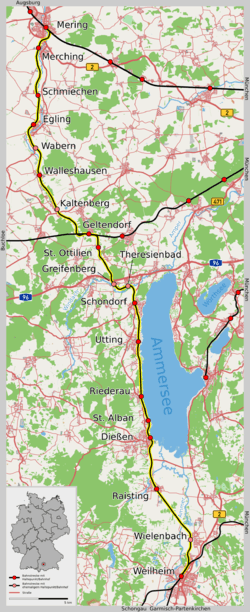Ammersee Railway
The Ammersee Railway (German: Ammerseebahn) is a 54 km long single-tracked main line in the provinces of Swabia and Upper Bavaria in southern Germany. It runs from Mering near Augsburg via Geltendorf to Weilheim and is listed by the Deutsche Bahn as Kursbuchstrecke 985.
| Ammersee Railway | ||||||||||||||||||||||||||||||||||||||||||||||||||||||||||||||||||||||||||||||||||||||||||||||||||||||||||||||||||||||||||||||||||||||||||||||||||||||||||||||||||||
|---|---|---|---|---|---|---|---|---|---|---|---|---|---|---|---|---|---|---|---|---|---|---|---|---|---|---|---|---|---|---|---|---|---|---|---|---|---|---|---|---|---|---|---|---|---|---|---|---|---|---|---|---|---|---|---|---|---|---|---|---|---|---|---|---|---|---|---|---|---|---|---|---|---|---|---|---|---|---|---|---|---|---|---|---|---|---|---|---|---|---|---|---|---|---|---|---|---|---|---|---|---|---|---|---|---|---|---|---|---|---|---|---|---|---|---|---|---|---|---|---|---|---|---|---|---|---|---|---|---|---|---|---|---|---|---|---|---|---|---|---|---|---|---|---|---|---|---|---|---|---|---|---|---|---|---|---|---|---|---|---|---|---|---|---|
A LINT train near Utting in 2013 | ||||||||||||||||||||||||||||||||||||||||||||||||||||||||||||||||||||||||||||||||||||||||||||||||||||||||||||||||||||||||||||||||||||||||||||||||||||||||||||||||||||
| Overview | ||||||||||||||||||||||||||||||||||||||||||||||||||||||||||||||||||||||||||||||||||||||||||||||||||||||||||||||||||||||||||||||||||||||||||||||||||||||||||||||||||||
| Other name(s) | Mering–Weilheim Railway | |||||||||||||||||||||||||||||||||||||||||||||||||||||||||||||||||||||||||||||||||||||||||||||||||||||||||||||||||||||||||||||||||||||||||||||||||||||||||||||||||||
| Native name | Ammerseebahn | |||||||||||||||||||||||||||||||||||||||||||||||||||||||||||||||||||||||||||||||||||||||||||||||||||||||||||||||||||||||||||||||||||||||||||||||||||||||||||||||||||
| Type | Heavy rail, Passenger rail Regional rail | |||||||||||||||||||||||||||||||||||||||||||||||||||||||||||||||||||||||||||||||||||||||||||||||||||||||||||||||||||||||||||||||||||||||||||||||||||||||||||||||||||
| Status | Operational | |||||||||||||||||||||||||||||||||||||||||||||||||||||||||||||||||||||||||||||||||||||||||||||||||||||||||||||||||||||||||||||||||||||||||||||||||||||||||||||||||||
| Locale | Bavaria | |||||||||||||||||||||||||||||||||||||||||||||||||||||||||||||||||||||||||||||||||||||||||||||||||||||||||||||||||||||||||||||||||||||||||||||||||||||||||||||||||||
| Termini | Mering Weilheim | |||||||||||||||||||||||||||||||||||||||||||||||||||||||||||||||||||||||||||||||||||||||||||||||||||||||||||||||||||||||||||||||||||||||||||||||||||||||||||||||||||
| Stations | 14 | |||||||||||||||||||||||||||||||||||||||||||||||||||||||||||||||||||||||||||||||||||||||||||||||||||||||||||||||||||||||||||||||||||||||||||||||||||||||||||||||||||
| Line number | 5370 | |||||||||||||||||||||||||||||||||||||||||||||||||||||||||||||||||||||||||||||||||||||||||||||||||||||||||||||||||||||||||||||||||||||||||||||||||||||||||||||||||||
| Operation | ||||||||||||||||||||||||||||||||||||||||||||||||||||||||||||||||||||||||||||||||||||||||||||||||||||||||||||||||||||||||||||||||||||||||||||||||||||||||||||||||||||
| Opened | 1898 | |||||||||||||||||||||||||||||||||||||||||||||||||||||||||||||||||||||||||||||||||||||||||||||||||||||||||||||||||||||||||||||||||||||||||||||||||||||||||||||||||||
| Owner | Deutsche Bahn | |||||||||||||||||||||||||||||||||||||||||||||||||||||||||||||||||||||||||||||||||||||||||||||||||||||||||||||||||||||||||||||||||||||||||||||||||||||||||||||||||||
| Operator(s) | Bayerische Regiobahn | |||||||||||||||||||||||||||||||||||||||||||||||||||||||||||||||||||||||||||||||||||||||||||||||||||||||||||||||||||||||||||||||||||||||||||||||||||||||||||||||||||
| Technical | ||||||||||||||||||||||||||||||||||||||||||||||||||||||||||||||||||||||||||||||||||||||||||||||||||||||||||||||||||||||||||||||||||||||||||||||||||||||||||||||||||||
| Line length | 54.6 km (33.9 mi) | |||||||||||||||||||||||||||||||||||||||||||||||||||||||||||||||||||||||||||||||||||||||||||||||||||||||||||||||||||||||||||||||||||||||||||||||||||||||||||||||||||
| Number of tracks | Single track | |||||||||||||||||||||||||||||||||||||||||||||||||||||||||||||||||||||||||||||||||||||||||||||||||||||||||||||||||||||||||||||||||||||||||||||||||||||||||||||||||||
| Track gauge | 1,435 mm (4 ft 8 1⁄2 in) standard gauge | |||||||||||||||||||||||||||||||||||||||||||||||||||||||||||||||||||||||||||||||||||||||||||||||||||||||||||||||||||||||||||||||||||||||||||||||||||||||||||||||||||
| Electrification | 15 kV/16.7 Hz AC Overhead line (Mering–Geltendorf) | |||||||||||||||||||||||||||||||||||||||||||||||||||||||||||||||||||||||||||||||||||||||||||||||||||||||||||||||||||||||||||||||||||||||||||||||||||||||||||||||||||
| Route number | 985 | |||||||||||||||||||||||||||||||||||||||||||||||||||||||||||||||||||||||||||||||||||||||||||||||||||||||||||||||||||||||||||||||||||||||||||||||||||||||||||||||||||
| ||||||||||||||||||||||||||||||||||||||||||||||||||||||||||||||||||||||||||||||||||||||||||||||||||||||||||||||||||||||||||||||||||||||||||||||||||||||||||||||||||||
Construction
The Mering–Geltendorf–Schondorf (29.77 km) and Weilheim–Dießen (13.07 km) sections were the first to be constructed. They were built by the Augsburg railway division of the Royal Bavarian State Railways and were completed simultaneously on 30 June 1898. The intervening 18.36 km section from Dießen to Schondorf was finished on 24 December 1898.
Electrification
The line was electrified between Mering and Geltendorf from 7 September 1970 in order to provide a diversionary line for the heavily trafficked trunk route from Augsburg to Munich, the Geltendorf–Munich-Passing having been electrified two years earlier.
Nowadays the Ammersee Railway in only of regional importance. Trains run hourly from Augsburg-Oberhausen via Weilheim to Schongau and back. Until the early 1990s there were still long-distance trains (the FD-Züge) on the line that did not take the 'bypass' via Munich on their way from the north of Germany to Garmisch-Partenkirchen, but went directly from Augsburg along the Ammersee Railway to Weilheim. One curious aspect was the mode of operation on the non-electrified section from Geltendorf to Weilheim. A diesel engine was hooked up to the train in Geltendorf or Weilheim and the electric locomotive was hauled along with its pantographs lowered.
This gap in the electrified network still remains a stumbling block, because all trains on the Ammersee Railway are diesel-hauled, although there is now catenary between Geltendorf and Augsburg. This excludes the few trains that, until the end of 2008, used to run only between Geltendorf and Augsburg in the morning and evening and were therefore hauled by electrics. A closure of this gap in the electrified network is planned in the longer term.
The long waits at some of the crossing stations and irregular services meant that travel on the Ammersee Railway was not particularly attractive in the past. This has changed since 14 December 2008 with a new, tauter timetable. The variable interval services have been restricted to the Dießen-Weilheim section. On the rest of the line, as on the through services to Schongau and Augsburg-Oberhausen, a strict hourly service is offered.
Since 14 December 2008, running powers on the Ammersee Railway have been awarded to the Bayerische Regiobahn (BRB). The BRB is a sister company of the Bayerische Oberlandbahn (BOB) and belongs to the Veolia Group. The BRB operates the Weilheim–Schongau and Augsburg–Geltendorf–Weilheim lines and, from 2009, has also worked the Augsburg–Aichach–Ingolstadt and Ingolstadt–Eichstätt Stadt routes.
Sources
- Dumjahn, Horst-Werner (1984). Handbuch der deutschen Eisenbahnstrecken; Eröffnungsdaten 1835-1935 [Nachdruck to Vorlage Reichsbahn 1935] (in German). Mainz: Dumjahn. ISBN 3-921426-29-4.
- Eisenbahnatlas Deutschland – Ausgabe 2007/2008 (in German). Vlg. Schweers + Wall, o.O. 2007. ISBN 978-3-89494-136-9.
- Janikowski, Andreas (1996). The Ammerseebahn, Verkehrsentwicklung im westlichen Oberbayern (in German). Stuttgart: Transpress. ISBN 3-344-71033-8.
External links
| Wikimedia Commons has media related to Ammerseebahn. |
